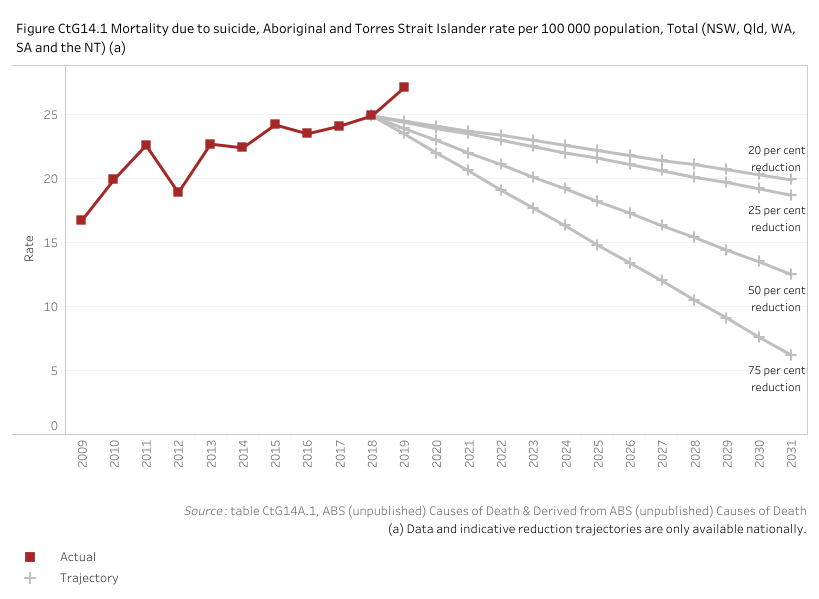TARGET 14
Significant and sustained reduction in suicide of Aboriginal and Torres Strait Islander people towards zero
Dashboard snapshot: The data below are the most recent at the time of preparing the July 2021 report. Please go to the dashboard to access the current data.
In 2019, the suicide rate for Aboriginal and Torres Strait Islander people was 27.1 per 100 000 people (for NSW, Queensland, WA, SA and the NT combined) (figure CtG14.1).
This is an increase from 24.9 per 100 000 people in 2018 (the baseline year).
Nationally, based on the most recent year of data, this target is not on track to be met.

The assessment below reflects progress from the baseline year to the current year (ie improvement or otherwise in the rate). This differs to the national assessment against the trajectory (above), which compares the current year rate to the rate on the target trajectory at the same time period.
Target data specifications
Outcome: | Aboriginal and Torres Strait Islander people enjoy high levels of social and emotional wellbeing. |
|---|---|
Target: | A significant and sustained reduction in suicide of Aboriginal and Torres Strait Islander people towards zero. There is no specified trajectory or expected timeline for achieving zero suicide. Four indicative reduction trajectories are presented for a 20 per cent, 25 per cent, 50 per cent, and 75 per cent reduction between the baseline year and target year. |
Indicator: | Suicide death rate of Aboriginal and Torres Strait Islander people. |
Measure: | The measure is defined as: Numerator — number of Aboriginal and Torres Strait Islander suicide deaths Denominator — number of Aboriginal and Torres Strait Islander people in the population and is presented as an age-standardised rate per 100 000 people. |
Target established: | National Agreement on Closing the Gap July 2020 |
Latest dashboard update: | 23 June 2021 |
Indicator type: | Target |
Interpretation of change: | A low or decreasing rate is desirable. A decrease from the baseline year is an improvement. |
Data source(s): | Name (numerator): Causes of Death, Australia Frequency: Annual Name (denominator): Estimates and Projections for Aboriginal and Torres Strait Islander population Frequency: Annual (data revised on a five-yearly basis) Documentation (links): https://www.abs.gov.au/statistics/health/causes-death/causes-death-australia/ |
Data provider: | Provider name: Australian Bureau of Statistics Provider area: Causes of Death |
Baseline year: | 2018 (data revised in 2021) |
Target year: | 2031 |
Disaggregations: | Age-standardised rates for single years: Total (of available jurisdictions — NSW, Queensland, WA, SA and the NT only), by sex (Males, Females, Persons), by year. Age-standardised rates for 5 years combined: state and territory (NSW, Queensland, WA, SA and the NT only) and Total (of available jurisdictions), by Indigenous status. |
Computation: | Numerator divided by Denominator multiplied by 100 000 Counting rules Numerator:
Denominator: Estimated population as at 30 June:
Age-standardised rate: Age-standardised rates are calculated using the direct method using 5-year age groups from 0–4 to 75 years and over, with the Australian standard population as at 30 June 2001. |
Data quality considerations: | Reporting of rates is only for those jurisdictions which have adequate levels of Indigenous identification (NSW, Queensland, WA, SA and the NT in line with national reporting guidelines). For jurisdictions, single year estimates are subject to volatility due to small numbers. Therefore, 5-year aggregates are provided for point-in-time comparisons for jurisdictions. All causes of death data from 2006 onward are subject to a revisions process. Once data for a reference year are 'final', they are no longer revised. Affected data in this table are: 2017 and prior (final), 2018 (revised), and 2019 (preliminary). See the Data quality section of the methodology in the Causes of Death, Australia, 2019 publication and Causes of Death Revisions, 2017 Final Data (Technical Note) and 2018 Revised Data (Technical Note) in Causes of Death, Australia, 2019 (cat. no. 3303.0). Coronial cases are more likely to be affected by a lag in registration time, especially those which are due to external causes, including suicide. Due to small numbers these lagged coroner-referred registrations can create large yearly variation in some causes of deaths of Aboriginal and Torres Strait Islander persons. Caution should be taken when making year to year analysis. Caution should be taken when interpreting figures relating to intentional self-harm and when conducting time series analysis (due to changes in Indigenous identification and causes of death coding processes over time). See Causes of Death, Australia methodology (www.abs.gov.au/methodologies/causes-death-australia-methodology). Data for Indigenous status are influenced by the quality of Aboriginal and Torres Strait Islander identification of people in the data collection, which is likely to differ across jurisdictions and over time. In 2019, there were 1362 deaths registered in Australia for whom Indigenous status was not stated, representing 0.8 per cent of all deaths registered. |
Future reporting: | Additional disaggregations required for future reporting:
|
Supporting indicators
Driver
- Non-fatal hospitalisations for intentional self-harm
- Intentional self-harm mortality rate (suicide)
- Hospitalisations for mental health-related disorders
Contextual information
- Proportion of Aboriginal and Torres Strait Islander people reporting experiencing psychological distress
- Proportion of people reported experiencing one of more barriers accessing health services
- Mental health-related disorders mortality rates
- Proportion who report having experienced racism in the previous 12 months
